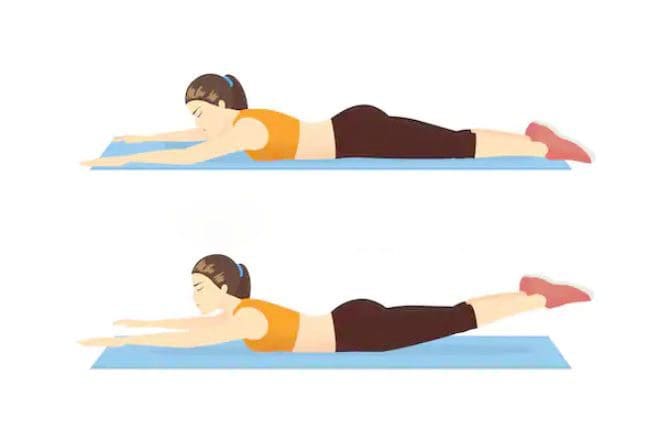The discs that cushion the vertebrae are made up of a tough outer layer and a softer inner layer. When the outer layer is damaged and the inner layer comes out into the spine, it is referred to as disc herniation.
Often the symptoms of a herniated disc include back pain, as the inner layer of the disc puts pressure on nerves in the spine. A herniated disc can impact the sciatic nerve, leading to sciatica.
If you know that your sciatica was caused by a herniated disc then try these exercises and stretches to help reduce back and leg pain.
Exercises that help relieve sciatica from a herniated disc
If your spine specialist or chiropractor informed you that a herniated disc is what caused the pain also known as lumbar radiculopathy they may recommend three sciatica exercises:- Prone on elbows into Press-up
- Upper back extension
- Opposite arm and leg extension
Prone Elbows/Press-Up
This exercise is to ease sciatica from herniated disc pain and pressure in the lumbar spine/low back.How to:
- Lay on stomach
- Slowly push up until rested on forearms
- Beginners hold for 30 seconds
- Once strength is gained and you feel comfortable then hold for 3 to 5 minutes
- Gently lower to the floor
- Repeat 10 times
- Once comfortable holding for 5 minutes then perform an extended arms version, which is like push-ups raising your arms to the point where your elbows lock
Upper Back Extension
This exercise is to strengthen and stabilize the low back muscles.How to:
- Lay on your stomach with a small pillow or rolled towel under your hips
- Rest your arms at your sides
- Slowly lift your upper body up off the floor, contracting your low back muscles as you rise
- Hold the lifted position for 3 seconds
- Slowly lower your body to the ground
- Repeat 10 times
Opposite Arm and Leg Extension
This exercise is to stabilize your spine and strengthen your low back, hamstring and gluteus muscles.How to:
- Lay on your stomach with a small pillow or rolled towel under your abdomen
- Extend both arms in front of you
- Contract your abdominal muscles as you slowly lift both your right arm and left leg
- Hold for 3 seconds. Lower your leg and arm down
- Repeat with your left arm and right leg
- Hold for 3 seconds
- Repeat the exercise 5 to 10 times on each side
How do these exercises relieve sciatica from a herniated disc
These exercises and stretches are designed to move the pain from the leg and into the low back.This is centralization/localization.
This is a good thing, as the goal is to get the pain centralized and back at the source.
When the leg pain goes away, it means the pressure on the sciatic nerve and related nerves has been removed.
If sciatic pain stretches down to the foot, you will feel these exercises, meaning that the pain and electrical sensations will move through the ankle and knee. Which means you're doing it correctly.
This does not mean that the pain is immediately going to centralize to the low back, it does take time because you are trying to stretch and straighten out this long nerve.
But you will notice sciatica pain does not go as far down the leg.
Therefore these exercises need to be done consistently and be made a part of your routine.
What to know before exercising
Before starting these stretches, consider three recommendations:Get a doctor’s approval
A spine specialist should clear you to perform these stretches and exercises before you start.While these exercises are safe, get a doctor’s permission before starting physical activity.
Know the cause so your exercise program helps and not makes the condition worse
Sciatica from herniated disc means a different type of exercise than sciatica caused by piriformis syndrome.Knowing this information will help you choose an exercise plan that provides maximum relief.
Don’t push too hard
Don't aggravate sciatica, listen to your body and go slow.Experience any pain or symptoms:
- Weakness
- Tingling
- Numbness
Sciatic nerve pain caused by a herniated or bulging disc is a common problem.
But incorporating these exercises and stretches can provide sustained relief.
The sciatic nerve is a large nerve that travels from the lower back down both of the legs and into the feet. When pressure is placed on the nerve, such as from a herniated disc, it can lead to the symptoms commonly referred to as sciatica.
The sciatic nerve can be impacted by a number of different things, including injury and degenerative diseases.
Difference Custom *FOOT ORTHOTICS* Make to Control Posture & Mobility | El Paso, TX (2019)
Custom foot orthotics can help control foot motion and posture. Healthcare professionals prescribe custom foot orthotics to help patients focus on the control of their foot posture and mobility. Research studies have determined that utilizing custom foot orthotics for posture and mobility control can help correct excessive foot pronation and supination to prevent a variety of foot health issues. The following video describes how custom foot orthotics can help control foot posture and mobility to improve health and wellness.
NCBI Resources
Sciatica is a common back ailment that affects approximately 1 in 10 adults in the United States. It is most prevalent in people between the ages of 25 and 45. Sciatica is characterized by a shooting pain that originates in the lower back and travels down through the hip, buttock, and back of the leg.The pain can be so severe that it inhibits mobility and can prevent people from working, taking care of their homes, or just enjoying their life. Traditionally, doctors have treated the condition with medications and some invasive therapies, but chiropractic treatments have been found to be extremely effective in alleviating the pain and curing the condition.








